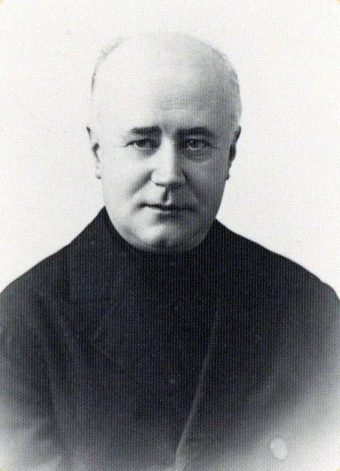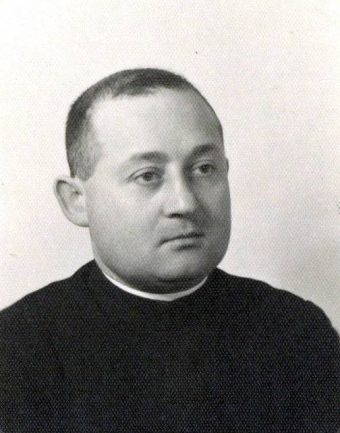Jesuit archivists of the Neapolitan Province

Which and how many Jesuits took care of the historical archives of the Neapolitan Province? Let’s find out together in this episode.
In one of the previous episodes of this column, we paid tribute to all the Jesuits who took care of the archives of the Roman Province. This is a cycle of episodes dedicated to all the Jesuit archivists for each historical former province, for a total of five episodes plus a sixth dedicated to the Province of Italy.
The Neapolitan Province
The historical archives of the Neapolitan Province were located in the Province offices at the Gesù Nuovo in Naples. There lived the archivists of the Province.
The Society of Jesus was able to reorganise itself with residences and apostolates in the Kingdom of Naples and Sicily before the official re-establishment of the order, thanks to the bull Sollecitudo omnium ecclesiarum of Pius VII.
No Jesuit archivist?
In contrast, however, to the Roman Province, the catalogues of the Neapolitan do not give us an appreciable amount of data; indeed, the first mention of a Jesuit archivist only dates back to 1931.
In fact, reading catalogues from the entire 19th century and the first half of the 20th century, one notices that, unfortunately, this position is never mentioned, whereas it is more common to find that of librarian.
Does this therefore mean that the provincial archive was in complete disrepair? We do not know the reason behind the absence of this data; perhaps those who compiled the catalogue did not consider it useful to indicate who was the Jesuit in charge of the archives. The compilation in fact, although following common rules, could vary from province to province.
Some possible reasons
The historical context must also be considered. The Jesuits living in Naples in the early 19th century no longer had historical archives to take care of. The documentation produced from 1540 to 1773 had in fact been confiscated after the suppression by the Kingdom of Naples. Probably the archives of the Curia of Naples consisted, in the first years of the reconstitution, only of current documentation and perhaps a few individual documents that escaped the suppression.
There are also other reasons. In fact, we must remember that the Risorgimento uprisings and the process of national unification led to the almost total dispersion of the documentation produced between the early 19th century and 1860, the year in which Naples was conquered and became part of the Kingdom of Italy officially proclaimed in March 1861.
The fonds of the Neapolitan Province, which are today kept in our archive, are particularly lacking for the years 1805 – 1861 and the following decade. The most homogeneous documentary production starts from the end of the 19th century, when the residences were reorganised a few decades after the Unification of Italy.
Whoever was assigned to the archive after 1880 was certainly confronted with a bleak situation: most of the old papers had been reincorporated during the Risorgimento and the archive work mainly concerned current files. These are the reasons that could explain the absence of a Jesuit in charge of the archive in so many annual historical catalogues.
The historical archives, however, were gradually reconstituted, also thanks to the files that became historical in the meantime and no longer for administrative use, the papers of deceased Jesuits and their personal files. The records of residences or schools that were being closed also arrived in the Province. It therefore became necessary to appoint a Jesuit to take care of this heritage.
1931: finally a Jesuit archivist in the catalogues
It is interesting to note that the first Jesuit from the Neapolitan province connected with the archives is a brother. He is Salvatore Cascella, defined as a helper to the keeper of the archives and the prefect of the library and living in the Gesù Nuovo residence.

It is never specified, however, who the custos archivii was, the Jesuit with whom Brother Cascella worked, we can assume that he was one of those living in the same residence that year.
Perhaps it could be Fr. Federico Lupi, minister of the Gesù Nuovo, whose various commitments included that of prefect of the library. Or we could speculate that it was Fr. Socio who was the custodian of the archives, as was the case more or less in the same years in the Roman Province, however for the Socio of the Neapolitan Province there are no references to the archives.
Brother Cascella is mentioned continuously as a helper to the custodian of the archives for several years until 1948, the last year in which the post is recorded. The role is always twofold: helper to the person in charge of the archives and to the prefect of the library, who for the Gesù Nuovo is always the minister, Francesco Lupi, for the whole time during which Cascella was the archivist.
Fr. Brother Cascella, however, continued his work as assistant to the Society even after 1948 until his death on 18 April 1958 in Naples at the age of 72, of which 47 years were spent in the Society of Jesus, of which 27 were spent as assistant to the Province Archivist.
The binomial brother coadjutor and archivist therefore seems to be reconfirmed. Even in the Roman Province we found as many as 4 brothers engaged for a long time in the archives.
With the death of Brother Cascella the role remained vacant until the appointment of a new provincial archivist, Fr Francesco Meduri, in 1958, for about ten years. He would take care of the historical archive for decades until his death in 1983.

P. Meduri was the last archivist of the Neapolitan Province. His successor, Fr. Filippo Iappelli, in fact was appointed the following year when the Province of Italy had already been established and we will speak about him in the dedicated article.
In the personal files of these Jesuits there are unfortunately no traces of the work done in the archives, as we have verified for the “colleagues” active in the Roman Province. Some traces of the work of the Jesuit archivists of the Neapolitan can be found in the photographic fund: in fact, Fr Meduri signs some captions of the photographs of the brethren or makes some handwritten notes manu propria.
Normally the destination as an archivist lasted only a few years, and around the first decades of the 1900s it was assigned to the Socius. Contrary to this custom, and as was the case with Fr Bizzochi in Rome at the same time, Fr Meduri held the post until his death.
The next instalment in this series dedicated to Jesuit archivists will cover the Veneto – Milanese province.
Maria Macchi











